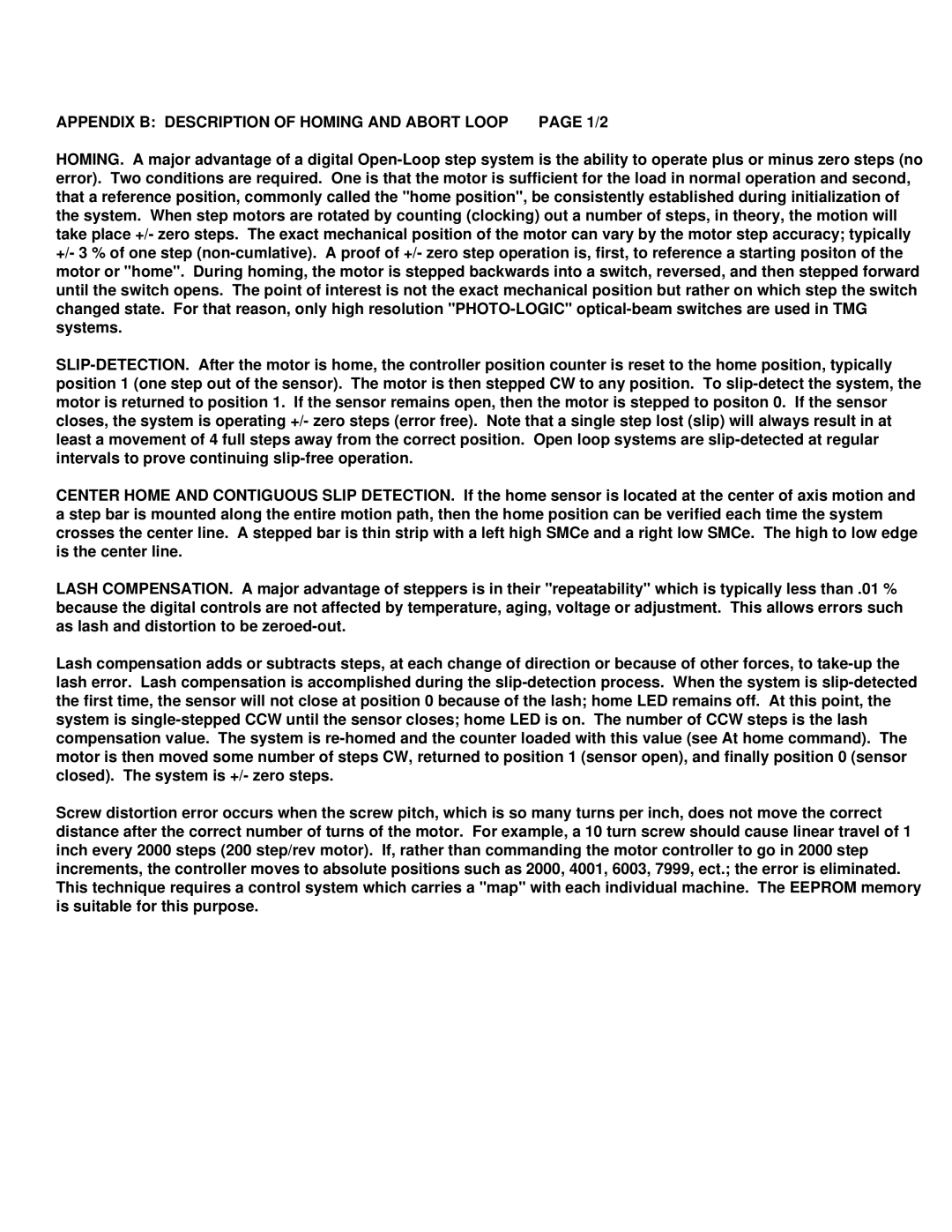APPENDIX B: DESCRIPTION OF HOMING AND ABORT LOOP PAGE 1/2
HOMING. A major advantage of a digital Open-Loop step system is the ability to operate plus or minus zero steps (no error). Two conditions are required. One is that the motor is sufficient for the load in normal operation and second, that a reference position, commonly called the "home position", be consistently established during initialization of the system. When step motors are rotated by counting (clocking) out a number of steps, in theory, the motion will take place +/- zero steps. The exact mechanical position of the motor can vary by the motor step accuracy; typically +/- 3 % of one step (non-cumlative). A proof of +/- zero step operation is, first, to reference a starting positon of the motor or "home". During homing, the motor is stepped backwards into a switch, reversed, and then stepped forward until the switch opens. The point of interest is not the exact mechanical position but rather on which step the switch changed state. For that reason, only high resolution "PHOTO-LOGIC" optical-beam switches are used in TMG systems.
SLIP-DETECTION. After the motor is home, the controller position counter is reset to the home position, typically position 1 (one step out of the sensor). The motor is then stepped CW to any position. To slip-detect the system, the motor is returned to position 1. If the sensor remains open, then the motor is stepped to positon 0. If the sensor closes, the system is operating +/- zero steps (error free). Note that a single step lost (slip) will always result in at least a movement of 4 full steps away from the correct position. Open loop systems are slip-detected at regular intervals to prove continuing slip-free operation.
CENTER HOME AND CONTIGUOUS SLIP DETECTION. If the home sensor is located at the center of axis motion and a step bar is mounted along the entire motion path, then the home position can be verified each time the system crosses the center line. A stepped bar is thin strip with a left high SMCe and a right low SMCe. The high to low edge is the center line.
LASH COMPENSATION. A major advantage of steppers is in their "repeatability" which is typically less than .01 % because the digital controls are not affected by temperature, aging, voltage or adjustment. This allows errors such as lash and distortion to be zeroed-out.
Lash compensation adds or subtracts steps, at each change of direction or because of other forces, to take-up the lash error. Lash compensation is accomplished during the slip-detection process. When the system is slip-detected the first time, the sensor will not close at position 0 because of the lash; home LED remains off. At this point, the system is single-stepped CCW until the sensor closes; home LED is on. The number of CCW steps is the lash compensation value. The system is re-homed and the counter loaded with this value (see At home command). The motor is then moved some number of steps CW, returned to position 1 (sensor open), and finally position 0 (sensor closed). The system is +/- zero steps.
Screw distortion error occurs when the screw pitch, which is so many turns per inch, does not move the correct distance after the correct number of turns of the motor. For example, a 10 turn screw should cause linear travel of 1 inch every 2000 steps (200 step/rev motor). If, rather than commanding the motor controller to go in 2000 step increments, the controller moves to absolute positions such as 2000, 4001, 6003, 7999, ect.; the error is eliminated. This technique requires a control system which carries a "map" with each individual machine. The EEPROM memory is suitable for this purpose.
